check engine light TOYOTA HILUX 2020 Owners Manual (in English)
[x] Cancel search | Manufacturer: TOYOTA, Model Year: 2020, Model line: HILUX, Model: TOYOTA HILUX 2020Pages: 744, PDF Size: 108.13 MB
Page 5 of 744
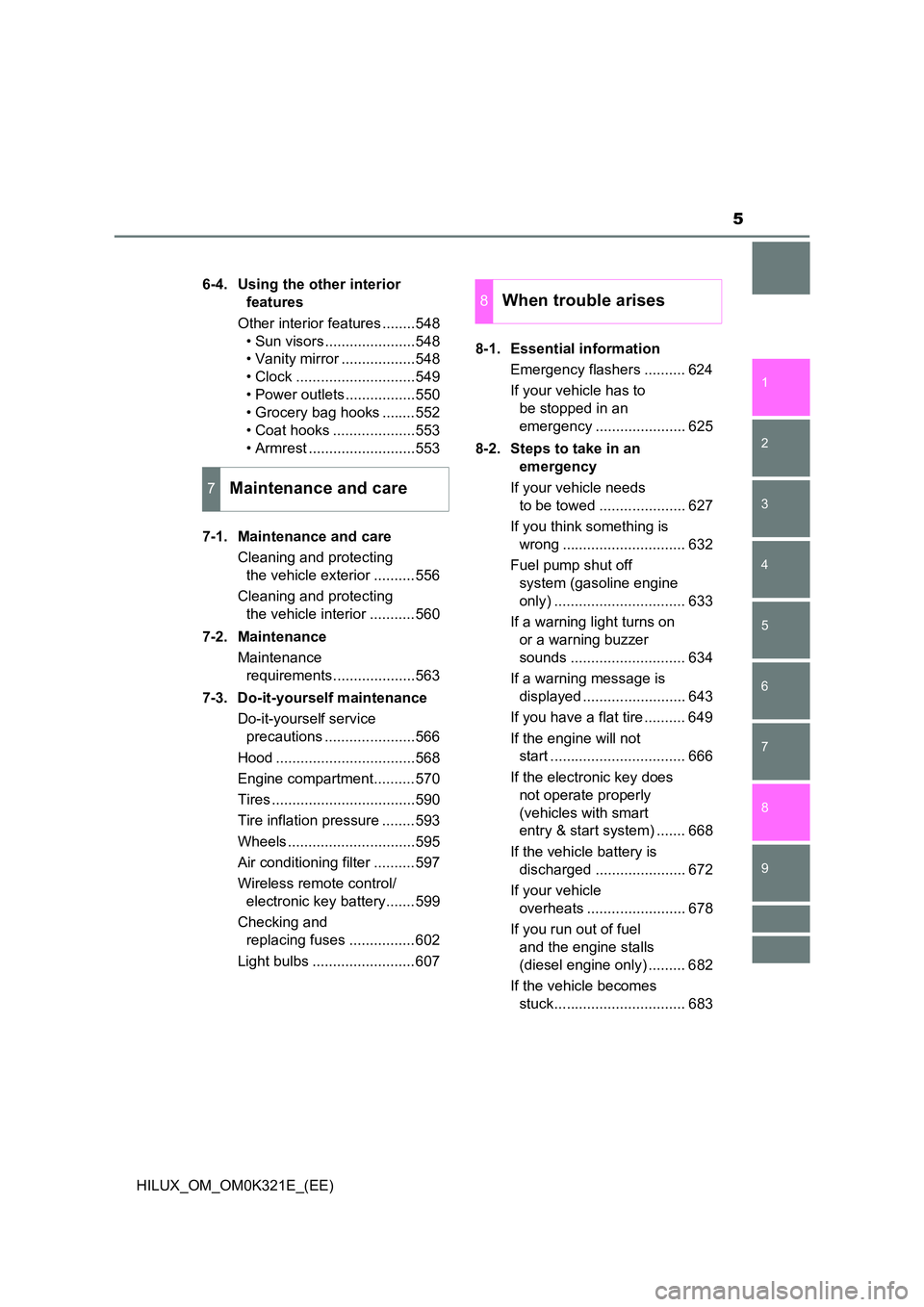
5
1
9
8
6
5
4
3
2
HILUX_OM_OM0K321E_(EE)
7
6-4. Using the other interior
features
Other interior features ........548
• Sun visors ......................548
• Vanity mirror ..................548
• Clock .............................549
• Power outlets .................550
• Grocery bag hooks ........552
• Coat hooks ....................553
• Armrest ..........................553
7-1. Maintenance and care
Cleaning and protecting
the vehicle exterior ..........556
Cleaning and protecting
the vehicle interior ...........560
7-2. Maintenance
Maintenance
requirements....................563
7-3. Do-it-yourself maintenance
Do-it-yourself service
precautions ......................566
Hood ..................................568
Engine compartment..........570
Tires ...................................590
Tire inflation pressure ........593
Wheels ...............................595
Air conditioning filter ..........597
Wireless remote control/
electronic key battery.......599
Checking and
replacing fuses ................602
Light bulbs .........................607
8-1. Essential information
Emergency flashers .......... 624
If your vehicle has to
be stopped in an
emergency ...................... 625
8-2. Steps to take in an
emergency
If your vehicle needs
to be towed ..................... 627
If you think something is
wrong .............................. 632
Fuel pump shut off
system (gasoline engine
only) ................................ 633
If a warning light turns on
or a warning buzzer
sounds ............................ 634
If a warning message is
displayed ......................... 643
If you have a flat tire .......... 649
If the engine will not
start ................................. 666
If the electronic key does
not operate properly
(vehicles with smart
entry & start system) ....... 668
If the vehicle battery is
discharged ...................... 672
If your vehicle
overheats ........................ 678
If you run out of fuel
and the engine stalls
(diesel engine only) ......... 682
If the vehicle becomes
stuck................................ 683
7Maintenance and care
8When trouble arises
Page 19 of 744
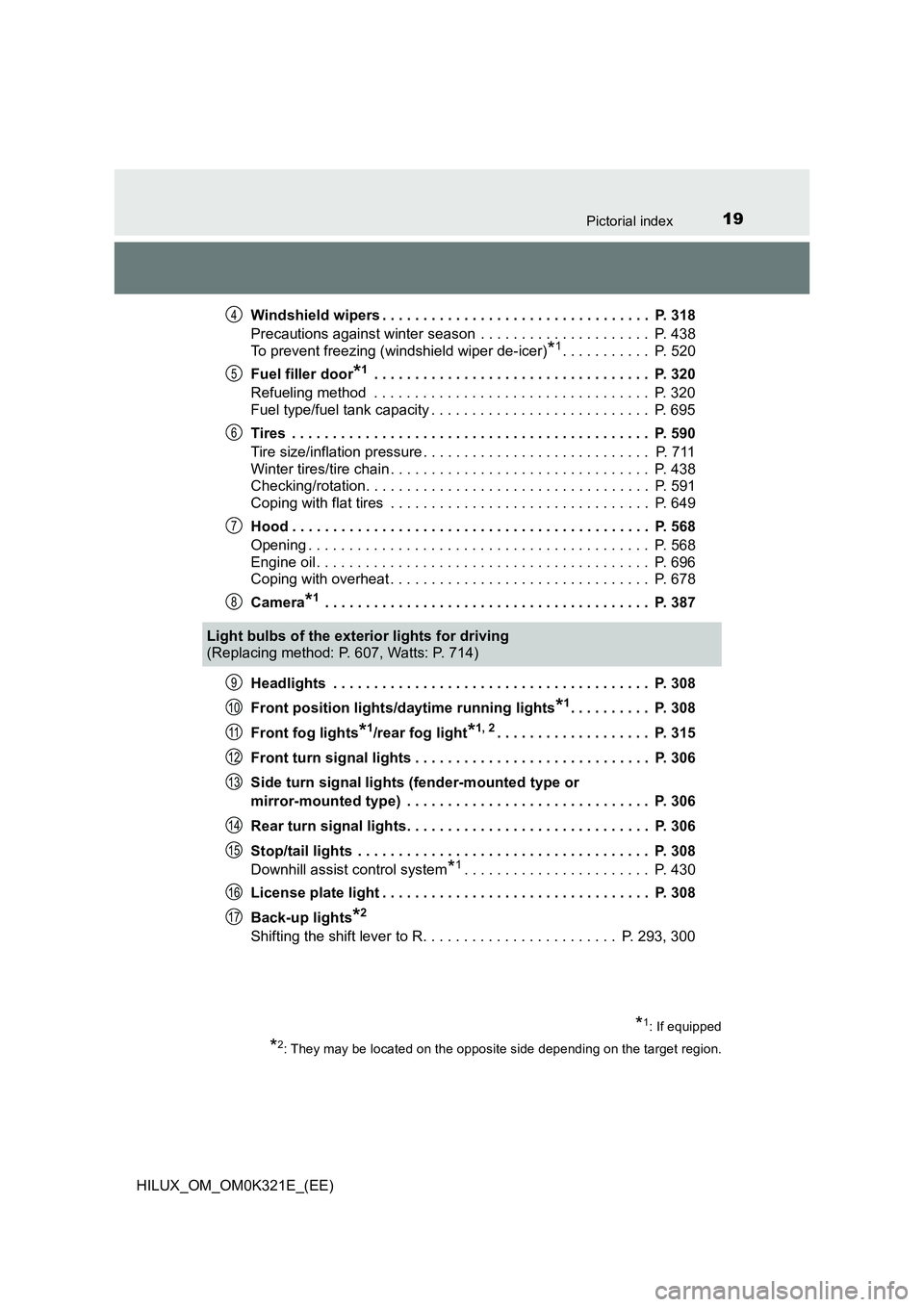
19Pictorial index
HILUX_OM_OM0K321E_(EE)
Windshield wipers . . . . . . . . . . . . . . . . . . . . . . . . . . . . . . . . . P. 318
Precautions against winter season . . . . . . . . . . . . . . . . . . . . . P. 438
To prevent freezing (windshield wiper de-icer)*1. . . . . . . . . . . P. 520
Fuel filler door*1 . . . . . . . . . . . . . . . . . . . . . . . . . . . . . . . . . . P. 320
Refueling method . . . . . . . . . . . . . . . . . . . . . . . . . . . . . . . . . . P. 320
Fuel type/fuel tank capacity . . . . . . . . . . . . . . . . . . . . . . . . . . . P. 695
Tires . . . . . . . . . . . . . . . . . . . . . . . . . . . . . . . . . . . . . . . . . . . . P. 590
Tire size/inflation pressure . . . . . . . . . . . . . . . . . . . . . . . . . . . . P. 711
Winter tires/tire chain . . . . . . . . . . . . . . . . . . . . . . . . . . . . . . . . P. 438
Checking/rotation. . . . . . . . . . . . . . . . . . . . . . . . . . . . . . . . . . . P. 591
Coping with flat tires . . . . . . . . . . . . . . . . . . . . . . . . . . . . . . . . P. 649
Hood . . . . . . . . . . . . . . . . . . . . . . . . . . . . . . . . . . . . . . . . . . . . P. 568
Opening . . . . . . . . . . . . . . . . . . . . . . . . . . . . . . . . . . . . . . . . . . P. 568
Engine oil . . . . . . . . . . . . . . . . . . . . . . . . . . . . . . . . . . . . . . . . . P. 696
Coping with overheat . . . . . . . . . . . . . . . . . . . . . . . . . . . . . . . . P. 678
Camera*1 . . . . . . . . . . . . . . . . . . . . . . . . . . . . . . . . . . . . . . . . P. 387
Headlights . . . . . . . . . . . . . . . . . . . . . . . . . . . . . . . . . . . . . . . P. 308
Front position lights/daytime running lights*1. . . . . . . . . . P. 308
Front fog lights*1/rear fog light*1, 2. . . . . . . . . . . . . . . . . . . P. 315
Front turn signal lights . . . . . . . . . . . . . . . . . . . . . . . . . . . . . P. 306
Side turn signal lights (fender-mounted type or
mirror-mounted type) . . . . . . . . . . . . . . . . . . . . . . . . . . . . . . P. 306
Rear turn signal lights. . . . . . . . . . . . . . . . . . . . . . . . . . . . . . P. 306
Stop/tail lights . . . . . . . . . . . . . . . . . . . . . . . . . . . . . . . . . . . . P. 308
Downhill assist control system*1. . . . . . . . . . . . . . . . . . . . . . . P. 430
License plate light . . . . . . . . . . . . . . . . . . . . . . . . . . . . . . . . . P. 308
Back-up lights*2
Shifting the shift lever to R. . . . . . . . . . . . . . . . . . . . . . . . P. 293, 300
4
5
6
7
8
Light bulbs of the exterior lights for driving
(Replacing method: P. 607, Watts: P. 714)
*1: If equipped
*2: They may be located on the opposite side depending on the target region.
9
10
11
12
13
14
15
16
17
Page 58 of 744
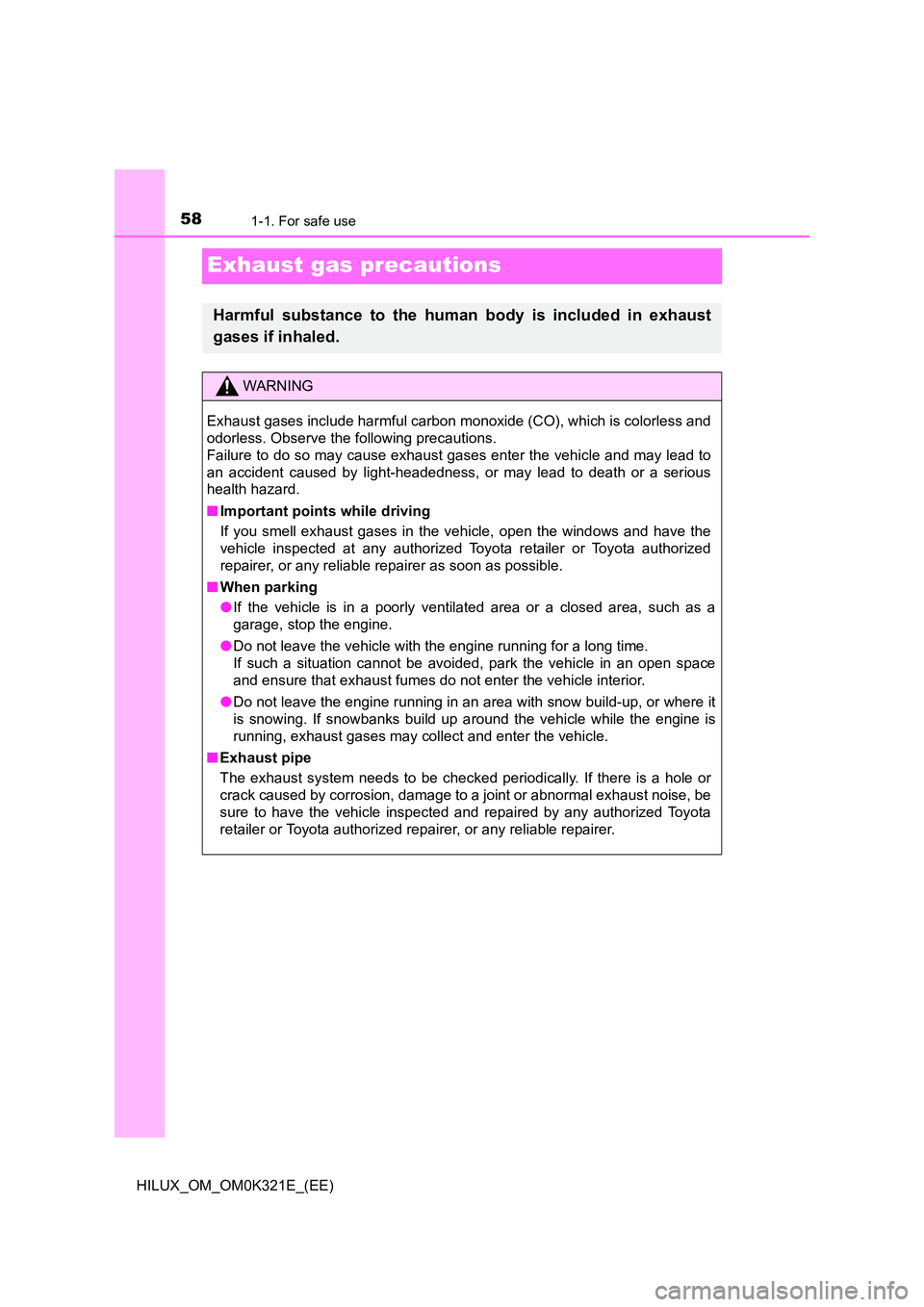
581-1. For safe use
HILUX_OM_OM0K321E_(EE)
Exhaust gas precautions
Harmful substance to the human body is included in exhaust
gases if inhaled.
WARNING
Exhaust gases include harmful carbon monoxide (CO), which is colorless and
odorless. Observe the following precautions.
Failure to do so may cause exhaust gases enter the vehicle and may lead to
an accident caused by light-headedness, or may lead to death or a serious
health hazard.
■ Important points while driving
If you smell exhaust gases in the vehicle, open the windows and have the
vehicle inspected at any authorized Toyota retailer or Toyota authorized
repairer, or any reliable repairer as soon as possible.
■ When parking
● If the vehicle is in a poorly ventilated area or a closed area, such as a
garage, stop the engine.
● Do not leave the vehicle with the engine running for a long time.
If such a situation cannot be avoided, park the vehicle in an open space
and ensure that exhaust fumes do not enter the vehicle interior.
● Do not leave the engine running in an area with snow build-up, or where it
is snowing. If snowbanks build up around the vehicle while the engine is
running, exhaust gases may collect and enter the vehicle.
■ Exhaust pipe
The exhaust system needs to be checked periodically. If there is a hole or
crack caused by corrosion, damage to a joint or abnormal exhaust noise, be
sure to have the vehicle inspected and repaired by any authorized Toyota
retailer or Toyota authorized repairer, or any reliable repairer.
Page 102 of 744
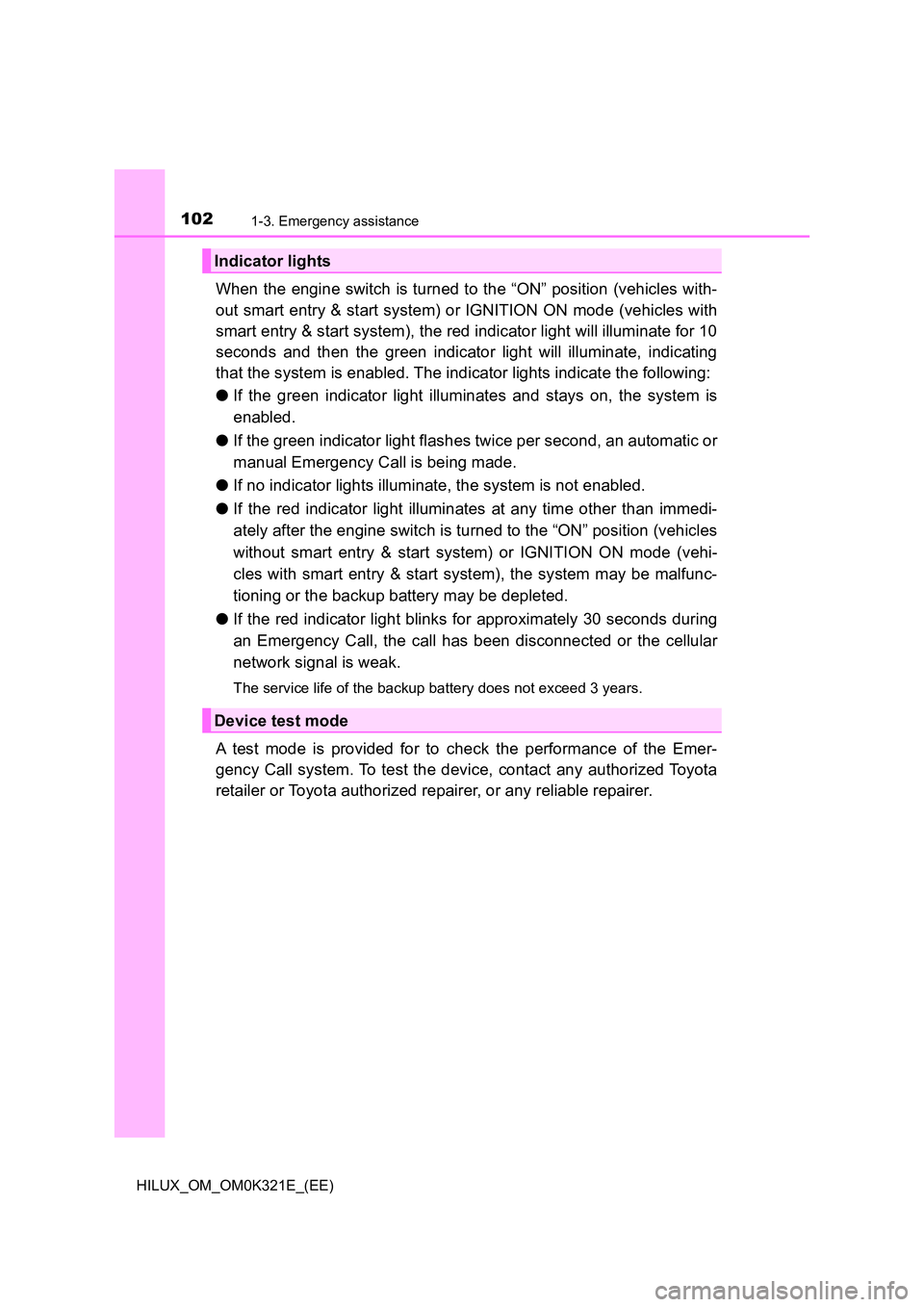
1021-3. Emergency assistance
HILUX_OM_OM0K321E_(EE)
When the engine switch is turned to the “ON” position (vehicles with-
out smart entry & start system) or IGNITION ON mode (vehicles with
smart entry & start system), the red indicator light will illuminate for 10
seconds and then the green indicator light will illuminate, indicating
that the system is enabled. The indicator lights indicate the following:
● If the green indicator light illuminates and stays on, the system is
enabled.
● If the green indicator light flashes twice per second, an automatic or
manual Emergency Call is being made.
● If no indicator lights illuminate, the system is not enabled.
● If the red indicator light illuminates at any time other than immedi-
ately after the engine switch is turned to the “ON” position (vehicles
without smart entry & start system) or IGNITION ON mode (vehi-
cles with smart entry & start system), the system may be malfunc-
tioning or the backup battery may be depleted.
● If the red indicator light blinks for approximately 30 seconds during
an Emergency Call, the call has been disconnected or the cellular
network signal is weak.
The service life of the backup battery does not exceed 3 years.
A test mode is provided for to check the performance of the Emer-
gency Call system. To test the device, contact any authorized Toyota
retailer or Toyota authorized repairer, or any reliable repairer.
Indicator lights
Device test mode
Page 137 of 744
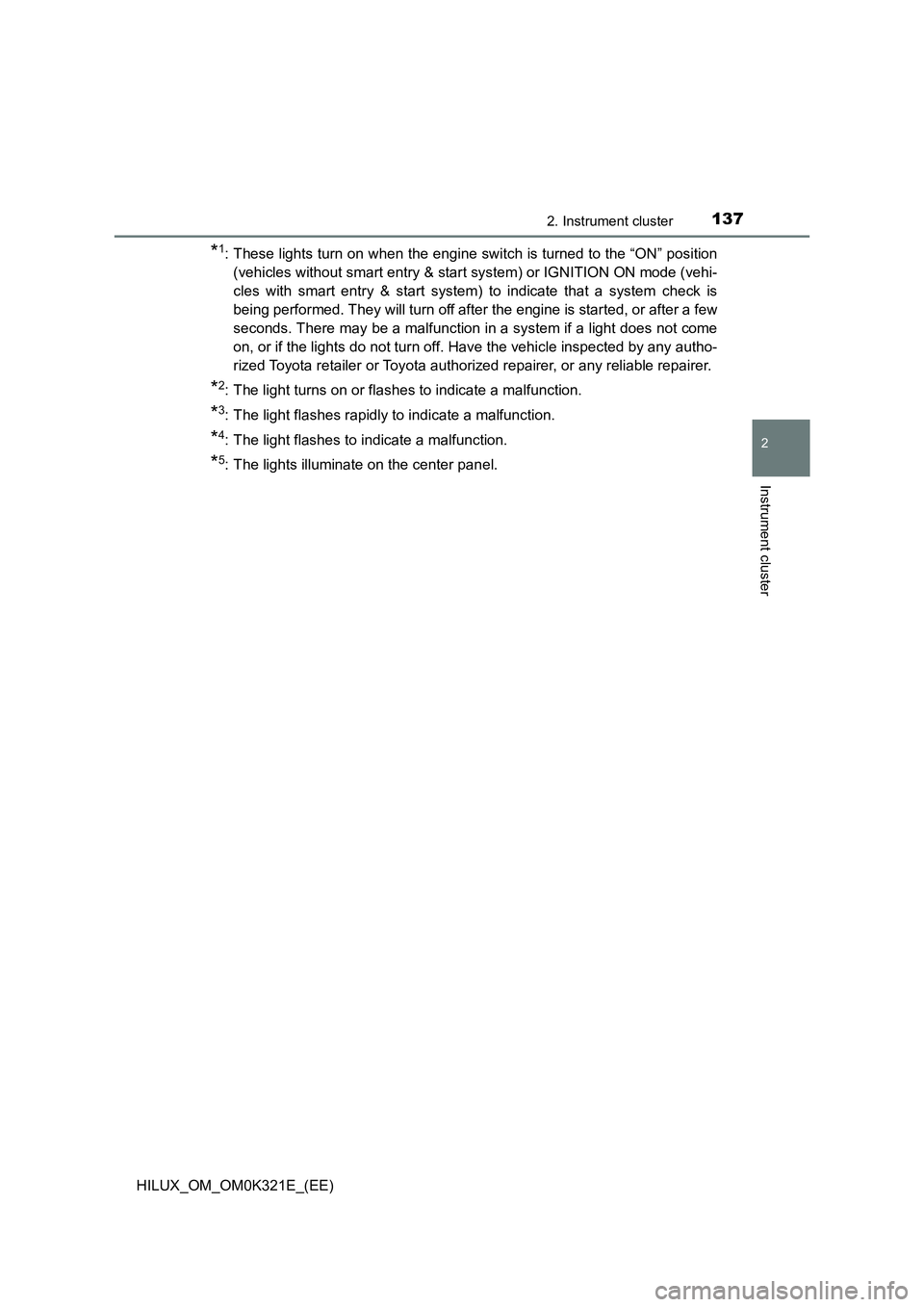
1372. Instrument cluster
2
Instrument cluster
HILUX_OM_OM0K321E_(EE)
*1: These lights turn on when the engine switch is turned to the “ON” position
(vehicles without smart entry & start system) or IGNITION ON mode (vehi-
cles with smart entry & start system) to indicate that a system check is
being performed. They will turn off after the engine is started, or after a few
seconds. There may be a malfunction in a system if a light does not come
on, or if the lights do not turn off. Have the vehicle inspected by any autho-
rized Toyota retailer or Toyota authorized repairer, or any reliable repairer.
*2: The light turns on or flashes to indicate a malfunction.
*3: The light flashes rapidly to indicate a malfunction.
*4: The light flashes to indicate a malfunction.
*5: The lights illuminate on the center panel.
Page 139 of 744

1392. Instrument cluster
2
Instrument cluster
HILUX_OM_OM0K321E_(EE)
*1: These lights turn on when the engine switch is turned to the “ON” position
(vehicles without smart entry & start system) or IGNITION ON mode (vehi-
cles with smart entry & start system) to indicate that a system check is
being performed. They will turn off after the engine is started, or after a few
seconds. There may be a malfunction in a system if a light does not come
on, or if the lights do not turn off. Have the vehicle inspected by any autho-
rized Toyota retailer or Toyota authorized repairer, or any reliable repairer.
*2: The light flashes to indicate that the system is operating.
*3: The light turns on when the system is turned off.
*4: Depending on the operating condition, the color and illuminating/flashing
state of the light change.
*5: The light illuminates on the center panel.
(if equipped)
Rear differential lock
indicator ( P. 408)(if equipped)
Low outside
temperature indicator
( P. 143)
*1, 3
(if equipped)
PCS warning light
( P. 339)
Parking brake indicator
light ( P. 307)
*4
(if equipped)
LDA indicator (P. 356)
*1, 5
(if equipped)
“PASSENGER AIR
BAG” indicator
( P. 59, 64)
Page 257 of 744
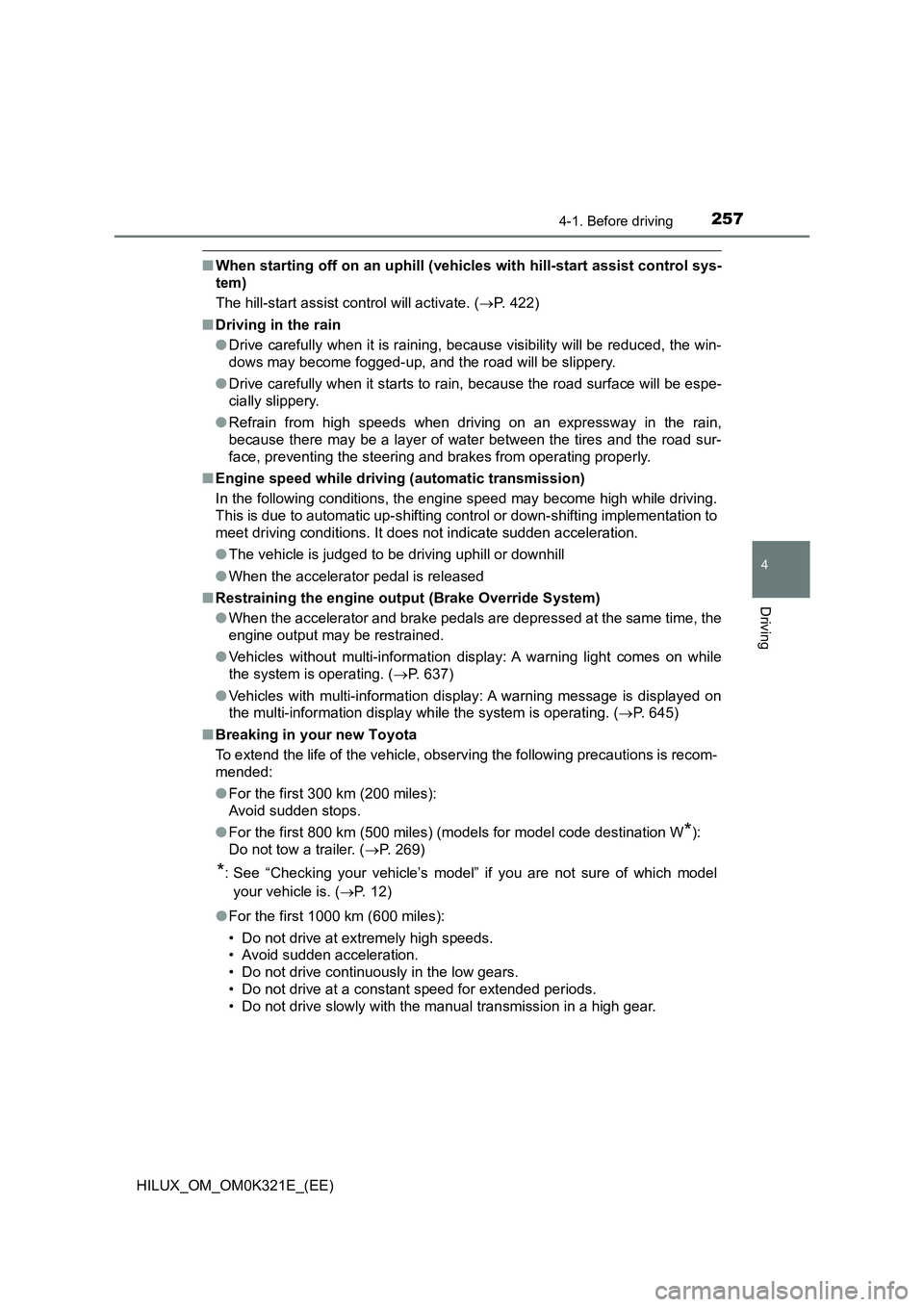
2574-1. Before driving
4
Driving
HILUX_OM_OM0K321E_(EE)
■When starting off on an uphill (vehicles with hill-start assist control sys-
tem)
The hill-start assist control will activate. ( P. 422)
■ Driving in the rain
● Drive carefully when it is raining, because visibility will be reduced, the win-
dows may become fogged-up, and the road will be slippery.
● Drive carefully when it starts to rain, because the road surface will be espe-
cially slippery.
● Refrain from high speeds when driving on an expressway in the rain,
because there may be a layer of water between the tires and the road sur-
face, preventing the steering and brakes from operating properly.
■ Engine speed while driving (automatic transmission)
In the following conditions, the engine speed may become high while driving.
This is due to automatic up-shifting c ontrol or down-shifting implementation to
meet driving conditions. It does not indicate sudden acceleration.
● The vehicle is judged to be driving uphill or downhill
● When the accelerator pedal is released
■ Restraining the engine output (Brake Override System)
● When the accelerator and brake pedals are depressed at the same time, the
engine output may be restrained.
● Vehicles without multi-information display: A warning light comes on while
the system is operating. ( P. 637)
● Vehicles with multi-information display: A warning message is displayed on
the multi-information display while the system is operating. ( P. 645)
■ Breaking in your new Toyota
To extend the life of the vehicle, observing the following precautions is recom-
mended:
● For the first 300 km (200 miles):
Avoid sudden stops.
● For the first 800 km (500 miles) (models for model code destination W*):
Do not tow a trailer. ( P. 269)
*: See “Checking your vehicle’s model” if you are not sure of which model
your vehicle is. ( P. 1 2 )
● For the first 1000 km (600 miles):
• Do not drive at extremely high speeds.
• Avoid sudden acceleration.
• Do not drive continuously in the low gears.
• Do not drive at a constant speed for extended periods.
• Do not drive slowly with the manual transmission in a high gear.
Page 260 of 744
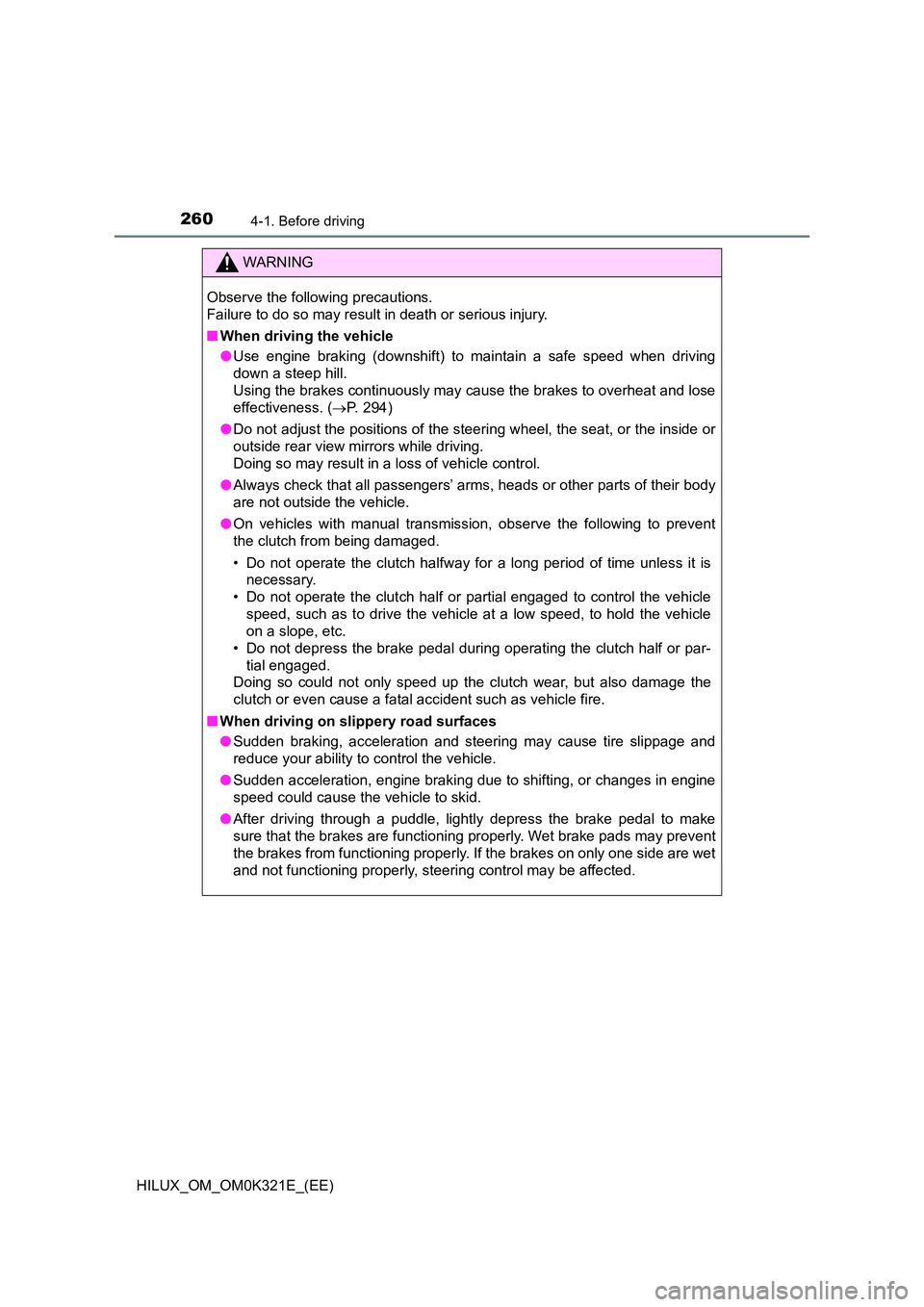
2604-1. Before driving
HILUX_OM_OM0K321E_(EE)
WARNING
Observe the following precautions.
Failure to do so may result in death or serious injury.
■ When driving the vehicle
● Use engine braking (downshift) to maintain a safe speed when driving
down a steep hill.
Using the brakes continuously may cause the brakes to overheat and lose
effectiveness. ( P. 2 9 4 )
● Do not adjust the positions of the steering wheel, the seat, or the inside or
outside rear view mirrors while driving.
Doing so may result in a loss of vehicle control.
● Always check that all passengers’ arms, heads or other parts of their body
are not outside the vehicle.
● On vehicles with manual transmission, observe the following to prevent
the clutch from being damaged.
• Do not operate the clutch halfway for a long period of time unless it is
necessary.
• Do not operate the clutch half or partial engaged to control the vehicle
speed, such as to drive the vehicle at a low speed, to hold the vehicle
on a slope, etc.
• Do not depress the brake pedal during operating the clutch half or par-
tial engaged.
Doing so could not only speed up the clutch wear, but also damage the
clutch or even cause a fatal accident such as vehicle fire.
■ When driving on slippery road surfaces
● Sudden braking, acceleration and steering may cause tire slippage and
reduce your ability to control the vehicle.
● Sudden acceleration, engine braking due to shifting, or changes in engine
speed could cause the vehicle to skid.
● After driving through a puddle, lightly depress the brake pedal to make
sure that the brakes are functioning properly. Wet brake pads may prevent
the brakes from functioning properly. If the brakes on only one side are wet
and not functioning properly, steering control may be affected.
Page 282 of 744

2824-2. Driving procedures
HILUX_OM_OM0K321E_(EE)
Engine (ignition) switch (vehicles without
smart entry & start system)
Automatic transmission (gasoline engine)
Check that the parking brake is set.
Check that the shift lever is set in P.
Firmly depress the brake pedal.
Turn the engine switch to the “START” position to start the engine.
Automatic transmission (diesel engine)
Check that the parking brake is set.
Check that the shift lever is set in P.
Firmly depress the brake pedal.
Turn the engine switch to the “ON” position.
The indicator turns on.
After the indicator light goes out, turn the engine switch to the
“START” position to start the engine.
Manual transmission (gasoline engine)
Check that the parking brake is set.
Check that the shift lever is set in N.
Firmly depress the clutch pedal.
Turn the engine switch to the “START” position to start the engine.
Manual transmission (diesel engine)
Check that the parking brake is set.
Check that the shift lever is set in N.
Firmly depress the clutch pedal.
Turn the engine switch to the “ON” position.
The indicator turns on.
After the indicator light goes out, turn the engine switch to the
“START” position to start the engine.
Starting the engine
1
2
3
4
1
2
3
4
5
1
2
3
4
1
2
3
4
5
Page 284 of 744
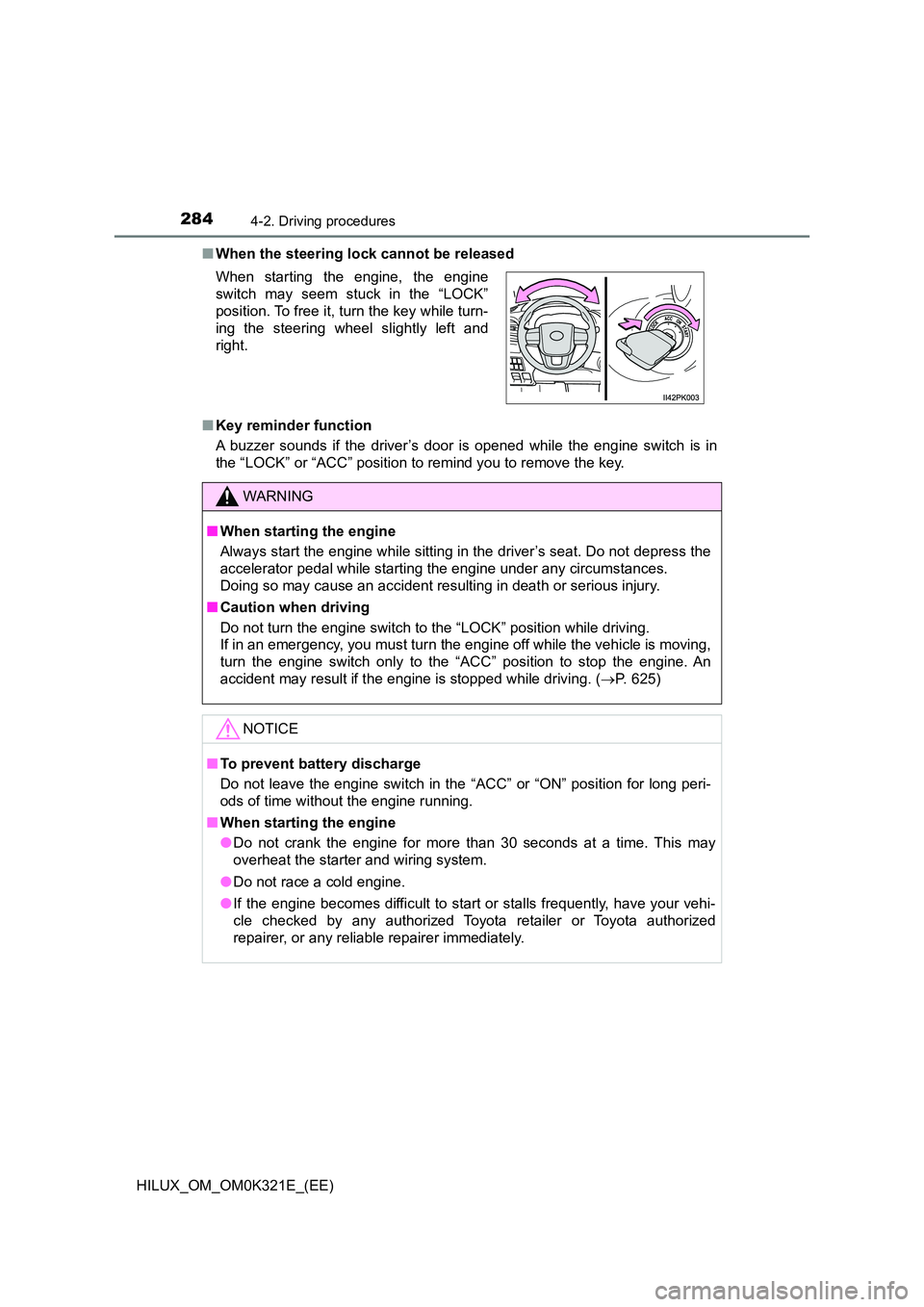
2844-2. Driving procedures
HILUX_OM_OM0K321E_(EE)
■ When the steering lock cannot be released
■ Key reminder function
A buzzer sounds if the driver’s door is opened while the engine switch is in
the “LOCK” or “ACC” position to remind you to remove the key.
When starting the engine, the engine
switch may seem stuck in the “LOCK”
position. To free it, turn the key while turn-
ing the steering wheel slightly left and
right.
WARNING
■ When starting the engine
Always start the engine while sitting in the driver’s seat. Do not depress the
accelerator pedal while starting the engine under any circumstances.
Doing so may cause an accident resulting in death or serious injury.
■ Caution when driving
Do not turn the engine switch to the “LOCK” position while driving.
If in an emergency, you must turn the engine off while the vehicle is moving,
turn the engine switch only to the “ACC” position to stop the engine. An
accident may result if the engine is stopped while driving. ( P. 625)
NOTICE
■To prevent battery discharge
Do not leave the engine switch in the “ACC” or “ON” position for long peri-
ods of time without the engine running.
■ When starting the engine
● Do not crank the engine for more than 30 seconds at a time. This may
overheat the starter and wiring system.
● Do not race a cold engine.
● If the engine becomes difficult to start or stalls frequently, have your vehi-
cle checked by any authorized Toyota retailer or Toyota authorized
repairer, or any reliable repairer immediately.